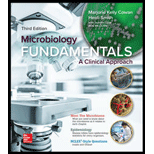
Microbiology Fundamentals: A Clinical Approach
3rd Edition
ISBN: 9781259709227
Author: Marjorie Kelly Cowan Professor, Heidi Smith
Publisher: McGraw-Hill Education
expand_more
expand_more
format_list_bulleted
Question
Chapter 14.4, Problem 9AYP
Summary Introduction
To determine:
The similarities and differences between type II and type III hypersensitivities.
Introduction:
The initial exposure to antigen results in the production of antibodies which circulate in body fluids. The second exposure of this antigen in body results in the formation of antigen-antibody (Ag-Ab) complexes. These Ag-Ab complexes recruits components of inflammatory reaction like complement and neutrophils. These complement eliminate Ag-Ab complex as normal immune response.
Expert Solution & Answer
Want to see the full answer?
Check out a sample textbook solution
Students have asked these similar questions
What is behavioral adapt
22. Which of the following mutant proteins is expected to have a dominant negative effect when over-
expressed in normal cells?
a. mutant PI3-kinase that lacks the SH2 domain but retains the kinase function
b. mutant Grb2 protein that cannot bind to RTK
c. mutant RTK that lacks the extracellular domain
d. mutant PDK that has the PH domain but lost the kinase function
e. all of the above
What is the label ?
Chapter 14 Solutions
Microbiology Fundamentals: A Clinical Approach
Ch. 14.1 - Define immunopathology, and identify the two major...Ch. 14.1 - Identify the four major categories of...Ch. 14.2 - Summarize genetic and environmental factors that...Ch. 14.2 - Identify three conditions caused by IgE-mediated...Ch. 14.2 - Identify the two clinical forms of anaphylaxis,...Ch. 14.2 - List the three main ways to prevent or...Ch. 14.2 - NCLEX PREP 1. During a visit to his physician, a...Ch. 14.2 - Prob. 2NPCh. 14.3 - List the three immune components causing cell...Ch. 14.3 - Prob. 8AYP
Ch. 14.4 - Prob. 9AYPCh. 14.4 - Medical Moment Patch Testing Patch testing is an...Ch. 14.5 - Prob. 10AYPCh. 14.5 - List four classes of grafts, and explain how host...Ch. 14.5 - NCLEX PREP 3. A patient receives a kidney...Ch. 14.6 - List at least three autoimmune diseases and the...Ch. 14.7 - Distinguish between primary and secondary...Ch. 14.7 - Medical Moment Hand Washing The importance of hand...Ch. 14.7 - Prob. 4NPCh. 14 - Allergy and atopy might have evolved in human...Ch. 14 - Can you think of a reason why humans have evolved...Ch. 14 - Prob. 3QCh. 14 - Prob. 4QCh. 14 - What feature of antibodies makes them particularly...Ch. 14 - Prob. 6QCh. 14 - Prob. 7QCh. 14 - Prob. 8QCh. 14 - Epi-pens are devices used to instantly inject a...Ch. 14 - Prob. 10QCh. 14 - Steroids administered to stop an allergic response...Ch. 14 - A very small number of people have a condition...Ch. 14 - Prob. 13QCh. 14 - Prob. 14QCh. 14 - Recent research shows that asthmatic patients have...Ch. 14 - Which statement is true of autoimmunity? a. It...Ch. 14 - It is often said that the normal microbiota of a...Ch. 14 - Investigate the link between Streptococcus...Ch. 14 - Which disease would be most similar to AIDS in its...Ch. 14 - Do you think people with B-cell deficiencies can...Ch. 14 - The chapter tells us that the gut microbiome of...Ch. 14 - Prob. 1VC
Knowledge Booster
Similar questions
- Can you described the image? Can you explain the question as well their answer and how to get to an answer to an problem like this?arrow_forwardglg 112 mid unit assignment Identifying melting processesarrow_forwardGive only the mode of inheritance consistent with all three pedigrees and only two reasons that support this, nothing more, (it shouldn't take too long)arrow_forward
- Oarrow_forwardDescribe the principle of homeostasis.arrow_forwardExplain how the hormones of the glands listed below travel around the body to target organs and tissues : Pituitary gland Hypothalamus Thyroid Parathyroid Adrenal Pineal Pancreas(islets of langerhans) Gonads (testes and ovaries) Placentaarrow_forward
- What are the functions of the hormones produced in the glands listed below: Pituitary gland Hypothalamus Thyroid Parathyroid Adrenal Pineal Pancreas(islets of langerhans) Gonads (testes and ovaries) Placentaarrow_forwardDescribe the hormones produced in the glands listed below: Pituitary gland Hypothalamus Thyroid Parathyroid Adrenal Pineal Pancreas(islets of langerhans) Gonads (testes and ovaries) Placentaarrow_forwardPlease help me calculate drug dosage from the following information: Patient weight: 35 pounds, so 15.9 kilograms (got this by dividing 35 pounds by 2.2 kilograms) Drug dose: 0.05mg/kg Drug concentration: 2mg/mLarrow_forward
- A 25-year-old woman presents to the emergency department with a 2-day history of fever, chills, severe headache, and confusion. She recently returned from a trip to sub-Saharan Africa, where she did not take malaria prophylaxis. On examination, she is febrile (39.8°C/103.6°F) and hypotensive. Laboratory studies reveal hemoglobin of 8.0 g/dL, platelet count of 50,000/μL, and evidence of hemoglobinuria. A peripheral blood smear shows ring forms and banana-shaped gametocytes. Which of the following Plasmodium species is most likely responsible for her severe symptoms? A. Plasmodium vivax B. Plasmodium ovale C. Plasmodium malariae D. Plasmodium falciparumarrow_forwardStandard Concentration (caffeine) mg/L Absorbance Reading 10 0.322 20 0.697 40 1.535 60 2.520 80 3.100arrow_forwardPlease draw in the missing answer, thank youarrow_forward
arrow_back_ios
SEE MORE QUESTIONS
arrow_forward_ios
Recommended textbooks for you
 Human Physiology: From Cells to Systems (MindTap ...BiologyISBN:9781285866932Author:Lauralee SherwoodPublisher:Cengage Learning
Human Physiology: From Cells to Systems (MindTap ...BiologyISBN:9781285866932Author:Lauralee SherwoodPublisher:Cengage Learning Human Biology (MindTap Course List)BiologyISBN:9781305112100Author:Cecie Starr, Beverly McMillanPublisher:Cengage Learning
Human Biology (MindTap Course List)BiologyISBN:9781305112100Author:Cecie Starr, Beverly McMillanPublisher:Cengage Learning


Human Physiology: From Cells to Systems (MindTap ...
Biology
ISBN:9781285866932
Author:Lauralee Sherwood
Publisher:Cengage Learning



Human Biology (MindTap Course List)
Biology
ISBN:9781305112100
Author:Cecie Starr, Beverly McMillan
Publisher:Cengage Learning
